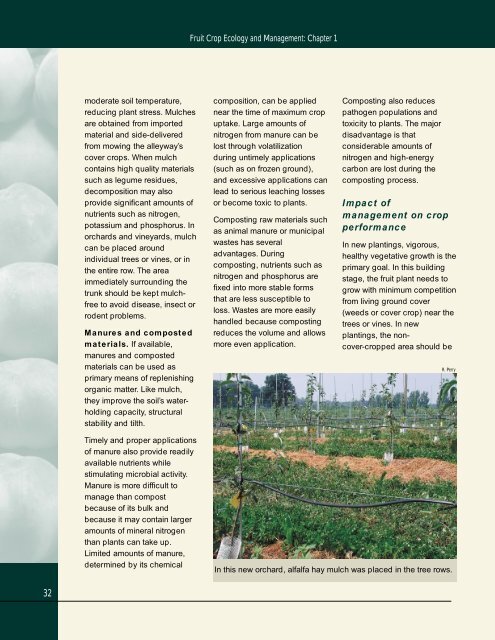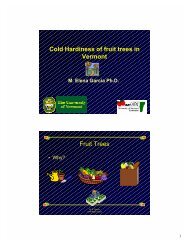Fruit Crop Ecology and Management - UVM Apple Orchard
Fruit Crop Ecology and Management - UVM Apple Orchard
Fruit Crop Ecology and Management - UVM Apple Orchard
Create successful ePaper yourself
Turn your PDF publications into a flip-book with our unique Google optimized e-Paper software.
32<br />
moderate soil temperature,<br />
reducing plant stress. Mulches<br />
are obtained from imported<br />
material <strong>and</strong> side-delivered<br />
from mowing the alleyway’s<br />
cover crops. When mulch<br />
contains high quality materials<br />
such as legume residues,<br />
decomposition may also<br />
provide significant amounts of<br />
nutrients such as nitrogen,<br />
potassium <strong>and</strong> phosphorus. In<br />
orchards <strong>and</strong> vineyards, mulch<br />
can be placed around<br />
individual trees or vines, or in<br />
the entire row. The area<br />
immediately surrounding the<br />
trunk should be kept mulchfree<br />
to avoid disease, insect or<br />
rodent problems.<br />
Manures <strong>and</strong> composted<br />
materials. If available,<br />
manures <strong>and</strong> composted<br />
materials can be used as<br />
primary means of replenishing<br />
organic matter. Like mulch,<br />
they improve the soil’s waterholding<br />
capacity, structural<br />
stability <strong>and</strong> tilth.<br />
Timely <strong>and</strong> proper applications<br />
of manure also provide readily<br />
available nutrients while<br />
stimulating microbial activity.<br />
Manure is more difficult to<br />
manage than compost<br />
because of its bulk <strong>and</strong><br />
because it may contain larger<br />
amounts of mineral nitrogen<br />
than plants can take up.<br />
Limited amounts of manure,<br />
determined by its chemical<br />
<strong>Fruit</strong> <strong>Crop</strong> <strong>Ecology</strong> <strong>and</strong> <strong>Management</strong>: Chapter 1<br />
composition, can be applied<br />
near the time of maximum crop<br />
uptake. Large amounts of<br />
nitrogen from manure can be<br />
lost through volatilization<br />
during untimely applications<br />
(such as on frozen ground),<br />
<strong>and</strong> excessive applications can<br />
lead to serious leaching losses<br />
or become toxic to plants.<br />
Composting raw materials such<br />
as animal manure or municipal<br />
wastes has several<br />
advantages. During<br />
composting, nutrients such as<br />
nitrogen <strong>and</strong> phosphorus are<br />
fixed into more stable forms<br />
that are less susceptible to<br />
loss. Wastes are more easily<br />
h<strong>and</strong>led because composting<br />
reduces the volume <strong>and</strong> allows<br />
more even application.<br />
Composting also reduces<br />
pathogen populations <strong>and</strong><br />
toxicity to plants. The major<br />
disadvantage is that<br />
considerable amounts of<br />
nitrogen <strong>and</strong> high-energy<br />
carbon are lost during the<br />
composting process.<br />
Impact of<br />
management on crop<br />
performance<br />
In new plantings, vigorous,<br />
healthy vegetative growth is the<br />
primary goal. In this building<br />
stage, the fruit plant needs to<br />
grow with minimum competition<br />
from living ground cover<br />
(weeds or cover crop) near the<br />
trees or vines. In new<br />
plantings, the noncover-cropped<br />
area should be<br />
R. Perry<br />
In this new orchard, alfalfa hay mulch was placed in the tree rows.



